QBARS - v19n4 Development of Promising Hybrid Rhododendrons Grown by Bill Whitney
Development of Promising Hybrid Rhododendrons
By Bill Whitney of Brinnon, Washington
Pat Cummins, Enumclaw, Wash.
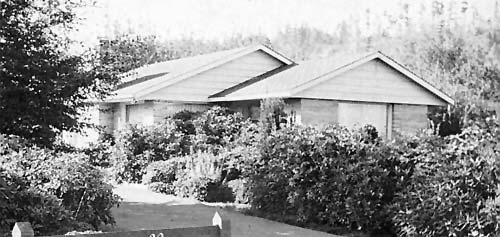
|
|
Fig. 50. Home of Mr. and Mrs. William Whitney at Brinnon,
Washington. Although submerged in luxuriant rhododendron foliage they find their home enhanced by the year around beauty of the plants and the cooling effect of their shade in the summer. Photo by Pat Cummins |
Every informed rhododendron enthusiast should know about the hybrid rhododendrons being developed on the shores of Hood Canal near the mouth of the Dosewallips River on the Olympic Peninsula of Washington State. Here Bill Whitney, a charter member of the American Rhododendron Society, patiently combines the genetic tendencies of many complex clones in a search for plants which are truly outstanding in foliage as well as flower.
Bill has been hybridizing since 1938 and now has produced up to five consecutive generations of blooming plants. His reluctance to name many clones stems from a deep conviction that plants worthy of introduction must exceed the standard plants of a given classification. These high standards are now beginning to bear additional fruit and the names of 'Honeymoon', 'Yellow Wing', 'Little Gem', 'Virginia Richards', and 'Hurricane' are going to take their place with other plants he has developed.
Now nearing seventy, Bill still is very active and has made an average of forty crosses per year over the past twenty-five years. During the winter months Bill finds time to plan the crosses he will make the following spring. He has several goals toward which he has made good progress. A guiding principle in achieving better plants has been to mix all the available genes of plants which could lead to a particular goal. In this regard he avoids making primary crosses since use of existing hybrids saves time and effort. For example he uses a clone he has developed as 26A ('Fabia' x 'Mrs. Furnival') for further crossing on such hybrids as 'Damaris' or 'Crest' in a quest for a better yellow. Plant form and foliage are given equal status with bloom, a mark of Whitney named hybrids. In the example just given he would be seeking a deeper yellow from the R. dichroanthum blood in 'Fabia' and the incorporation of the excellent form and foliage of 'Mrs. Furnival' by crossing 26A with a quality yellow clone.
Breeding Goals
Bill's early interest was in developing yellow hybrids and he will soon have quantities of 'Honeymoon' and 'Yellow Wing' on the market as evidence of considerable success in this line.
He is still working on dwarf reds and finds Kingdon Ward's No. 7725 form of R. elliottii to be an excellent parent. 'Little Gem' is an example of his work here. 'Blue Pacific', a selected clone of 'Susan' x 'Purple Splendor' is a result of his interest in blue elepidotes. Another goal of Whitney crosses is large size of flower. He has developed 'Hurricane' which is similar to 'Mrs. Furnival' but has floral parts that are much larger.
After years of hybridizing Bill now feels that his main goal should be to produce pastel shades of different colors on plants that root readily are low and compact with R. orbiculare or R. cardiobasis type leaves, are hardy, and do well in full sun.
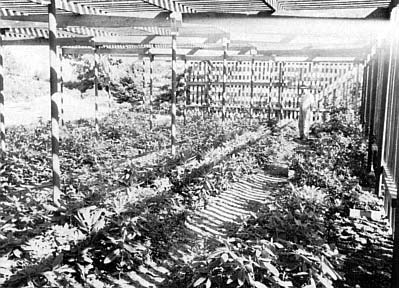
|
|
Fig. 51. Lath House at Whitney's Nursery. Here the seedlings
are planted out from flats to grow in ideal conditions until they are planted in the field for final evaluation. Photo by Pat Cummins |
Breeding Techniques
When making a cross he removes the corolla and stamens to avoid contaminating pollen. The exception to this practice is the four days of protection with polyethylene which he gives selfed florets.
After picking the seed in the fall and storing it in a cool place, he sows it on the first of February with an 80°F. germination temperature. He gradually cools the seed flat to 68°F. when the first true leaves form. Sixty-five seedlings are transplanted to a flat with a mixture of river silt, peat moss, rotted sawdust, and sand. The seed flat is kept under open lath for two years and is moved into lath beds at age three.
The rigors of selection begin at this point as he culls the surviving seedlings for poor foliage in the lath bed to cut the number of plants to around forty per cross. At age four or five he moves the plants into the open field. He finds that these techniques result in a blooming age of six years on the average. Upon blooming he further culls the growing stock. Any promising plants are bloomed three times prior to evaluation.
The following genealogical charts trace the development and show the gene pool represented in five of his recently developed hybrids.

The final cross yielded several better than average clones with just one outstanding. 'Honeymoon' is a chartreuse yellow, early blooming (April), H-2 (ARS 1961), semi-dwarf growing to 3½ feet in 10 years with a dense rounded plant form and heart shaped leaves with a shiny luster.

The final cross yielded just one outstanding clone out of fifty plants. 'Yellow Wing' is a true yellow, mid season bloomer, H-3 (ARS 1961), semi dwarf growing to four feet in ten years.

Most of the seedlings from this cross were superior. 'Little Gem' is blood red, mid season bloomer, H-4 (ARS 1961), with a dwarf compact habit.

The final cross had mostly superior seedlings. 'Virginia Richards' has a pink overcast when it opens which changes to primrose yellow, mid season bloomer, H-3 (ARS 1961), growing to five feet in ten years with (lark green foliage which is beautifully held on the plant.

The final cross yielded only one outstanding clone out of fifty plants. 'Hurricane' has the pink color of 'Mrs. Furnival', mid season bloomer, H-2 (ARS 1961), growing to seven feet in ten years, and has large floral parts and large dark green leaves held beautifully as they are on 'Anna Rose Whitney'.
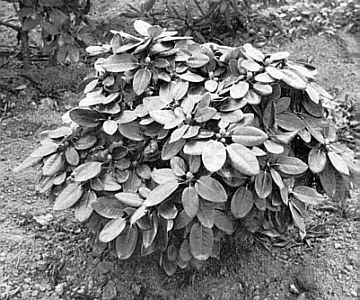
|
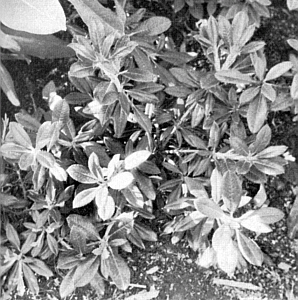
|
|
Fig. 52. Rhododendron 'Honeymoon'. In form, foliage
and rate of growth this hardy plant with its chartreuse yellow trusses should become a standard for lovers of the genus. Photo by Pat Cummins |
Fig. 53. Rhododendron 'Little Gem'. A
charming dwarf with blood red flowers and "new-looking" foliage. A credit to its outstanding parents, R. elliottii , K. W. No. 7725 rhododendron 'Carmen'. |
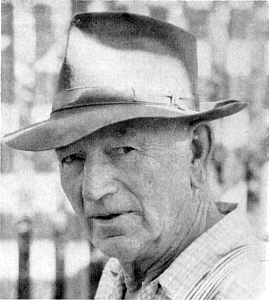
|
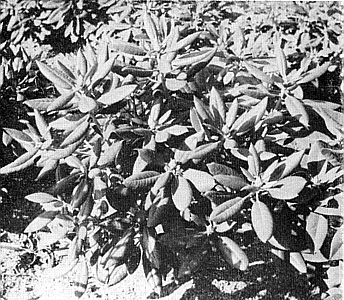
|
|
Fig. 54. William E. Whitney, Hybridizer
plantsman, and Charter Member of the American Rhododendron Society. Photo by Pat Cummins |
Fig. 55. Rhododendron 'Virginia Richards'.
Opening rose and changing to yellow, the foliage and form of this plant mark its year around beauty. Photos by Pat Cummins |
The Whitney Nursery is a veritable magnet for people touring the Olympic Peninsula from April to June. The sight of large specimen plants in bloom literally stops traffic at times. A tour of the open fields and lath house is rewarding to novice and expert alike. The species enthusiast can see excellent Whitney-selected forms of R. moupinense and R. yakushimanum plus a collection of large leaved species. Bill Whitney has made a significant contribution to the world of rhododendrons by combining the genes of many plants to achieve beauty in flower and form.
